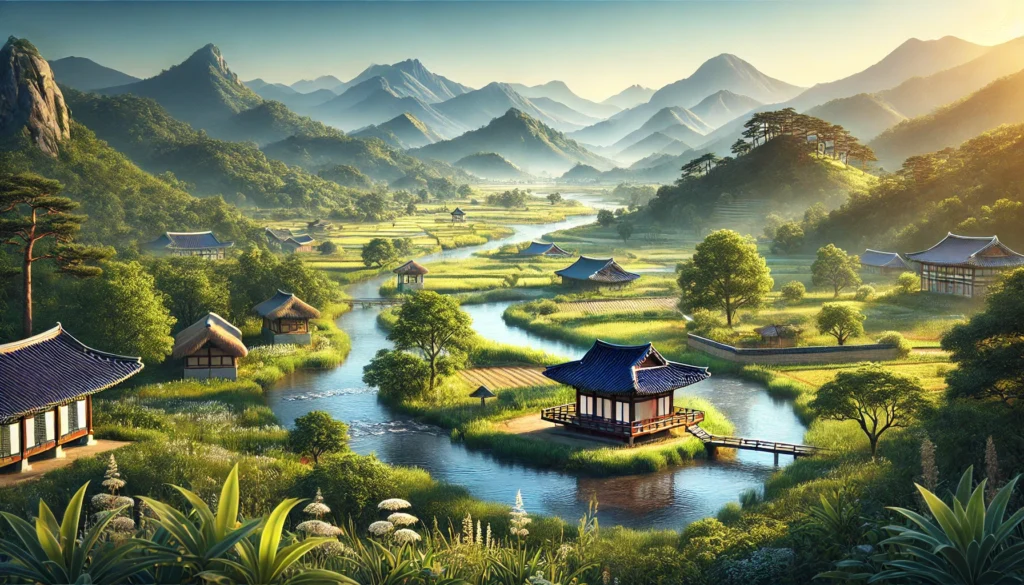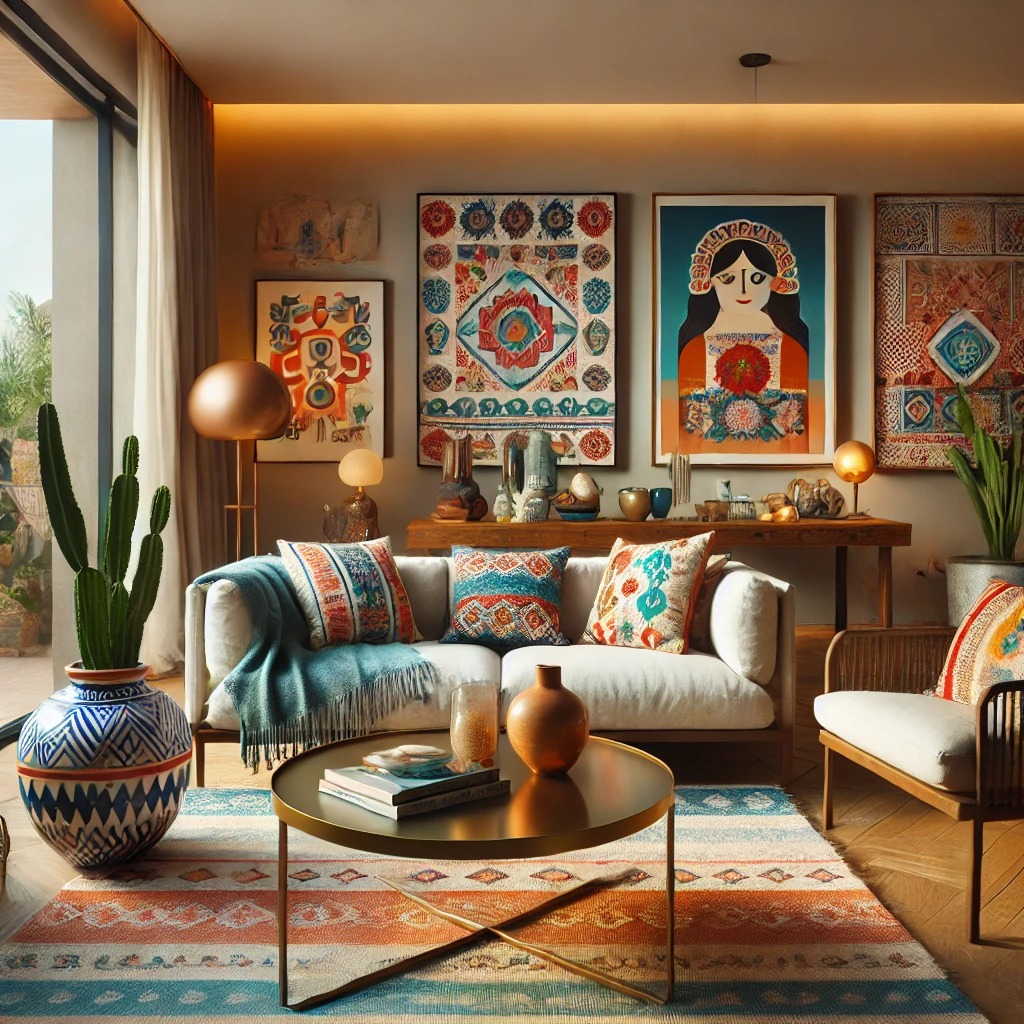Table of Contents
Introduction to Korea’s Natural Beauty
Korea is a land adorned with diverse and breathtaking natural landscapes that range from majestic mountains to tranquil coastlines for inspiration. The country boasts a unique geographical tapestry, characterized by soaring peaks, shimmering rivers, lush forests, and dramatic shores. These elements combine to create a stunning backdrop that significantly influences both the local culture and the artistic expressions found in various areas of design, architecture, and art.
The mountainous terrains, including iconic ranges such as the Taebaek and Sobaek, serve as a cornerstone of Korea’s natural identity. These mountains not only provide picturesque vistas but also play a pivotal role in shaping the climatic conditions and biodiversity of the region. Visitors are often drawn to the beauty of places like Seoraksan National Park, where the interplay of rugged rocks and vibrant flora cultivates a sense of tranquility and splendor.
Similarly, Korea’s extensive river systems, notably the Han River, meander through urban landscapes, providing aesthetic value and vital resources for countless communities. These waterways are not merely functional but inspire a sense of harmony between the built environment and nature, which is deeply embedded in Korean architectural philosophy.
In addition, the country’s forests are a treasure trove of biodiversity, with native species contributing to the vibrant ecological fabric of the nation. These forests foster a profound connection to nature, reflected in traditional Korean art forms, which often draw upon the visual and tactile experiences of the outdoors. Likewise, Korea’s picturesque coastlines, punctuated by idyllic beaches and rugged cliffs, further enhance the nation’s landscapes and evoke a deep appreciation for the natural world.

As we explore the design ideas emerging from these natural elements, it becomes clear that Korea’s geographical features not only define its scenery but also inspire a cultural dialogue about the relationship between humanity and nature. The intrinsic beauty found in Korea’s landscapes plays a crucial role in guiding contemporary design, blending aesthetics with a respect for the environment.
Understanding the Importance of Nature in Korean Culture
The relationship between Koreans and their natural environment is deeply rooted in the country’s history and cultural practices. Traditional philosophies such as Confucianism and Shamanism have profoundly influenced the way nature is perceived and revered in Korea. Confucianism, which emphasizes harmony and balance, encourages individuals to live in a way that respects the rhythms of nature. This philosophy advocates for a life that aligns with natural cycles, fostering an understanding of the interconnectedness between humans and their surroundings.
Shamanism, on the other hand, plays a crucial role in shaping the spiritual connection Koreans have with nature. It recognizes that natural elements possess spiritual significance, with mountains, rivers, and trees often seen as sacred entities. This belief system fosters a deep respect for the environment, leading to practices that honor and preserve the natural world. The veneration of spirits residing in nature not only cultivates a reverence for the outdoor landscape but also integrates these elements into traditional rituals and artistic expressions.
This cultural reverence for nature is vividly reflected in various aspects of Korean life. From traditional architecture designed to blend harmoniously with its surroundings to artistic representations that celebrate natural beauty, nature remains a fundamental influence in Korean design. Paintings, poetry, and crafts often draw inspiration from the seasonal changes and diverse landscapes, showcasing the intricate relationship between the environment and Korean identity.
Understanding this historical and cultural context is essential in appreciating how nature has shaped not just the physical landscape of Korea, but also its artistic and design philosophies. By recognizing the significance of nature in Korean culture, one can better understand the underlying principles that inspire contemporary Korean design, as well as the enduring bond between people and their natural surroundings.
Elements of Korea’s Landscapes: Colors, Textures, and Patterns
The natural landscapes in Korea are characterized by a diverse palette of colors, rich textures, and unique patterns that profoundly influence design aesthetics. One prominent feature is the vibrant hues of cherry blossoms in spring, which can serve as an invigorating inspiration for color palettes in various design projects. The delicate pinks and whites of these blossoms evoke feelings of renewal and tranquility, making them ideal for spaces intended for relaxation or reflection. Designers can incorporate these soft tones into interior spaces, branding, or product designs to create an atmosphere that resonates with serenity and beauty.
In stark contrast to the delicate beauty of cherry blossoms, Korea’s rocky mountains present a different array of textures and tones. The rugged surfaces and varied hues of granite and limestone create a sense of strength and durability. Designers might draw upon the earthy browns, soft grays, and mossy greens found in these mountains to establish a grounded, naturalistic aesthetic. By integrating textured materials that mimic the roughness of stone or incorporate earth-inspired colors, spaces can achieve a balance of sophistication and organic influence.
Another notable feature of Korea’s landscapes is the intricate patterns formed by rice fields. The tiered layers of green paddies reflect the harmony between nature and agriculture, offering a striking visual rhythm. This geometric arrangement can inspire design motifs that employ repetition and balance. By utilizing similar patterns in textiles, wallpapers, or architectural designs, one can evoke a sense of structure and harmony reminiscent of these fertile landscapes. Overall, the colors, textures, and patterns found in Korea’s natural environments provide a rich source of inspiration, encouraging designers to create spaces that echo the beauty and complexity of the world around them.
Incorporating Natural Landscapes into Modern Design
In recent years, the integration of nature into modern design has gained significant attention, driven by a growing awareness of the importance of biophilic design principles. This approach emphasizes the connection between human beings and the natural environment, fostering well-being and enhancing the functionality of living spaces. One effective method is the incorporation of natural landscapes into architectural and interior design, creating harmonious relationships between indoor and outdoor environments.
Case studies of various projects demonstrate the successful blending of natural elements with contemporary architecture. For instance, the use of large windows and open floor plans allows for ample natural light and unobstructed views of the surrounding landscapes. This not only creates a sense of spaciousness but also encourages occupants to engage with the outdoors. Moreover, strategic landscaping can create a seamless transition between internal and external spaces, reinforcing the presence of nature within the design.
The application of natural materials such as wood, stone, and plant life further enhances the aesthetic appeal and functionality of spaces. These materials not only provide visual warmth but also have been shown to improve air quality and promote a sense of tranquility. Designers are increasingly opting for sustainable materials and eco-friendly construction practices, recognizing the impact of their choices on both the environment and the well-being of the occupants.
Additionally, incorporating nature can greatly enhance cognitive function and emotional health. Spaces designed with nature in mind can lead to reduced stress levels and increased productivity, making them ideal for both residential and commercial settings. By understanding the advantages of merging natural landscapes with modern design, architects and designers can create environments that not only meet aesthetic preferences but also support sustainable living and improved mental health.
Lessons from Traditional Korean Architecture
Traditional Korean architecture offers a remarkable example of how structures can blend harmoniously with the natural environment. Central to this architectural philosophy is the Hanok, a traditional Korean house that reflects a deep respect for nature and a commitment to sustainability. Hanok design principles incorporate natural materials such as wood, clay, and stone, which not only enhance aesthetic appeal but also promote environmental harmony.
The adaptability of Hanok structures is another significant aspect worth noting. Traditional Korean houses are designed to accommodate seasonal changes, ensuring comfort and functionality throughout the year. For instance, the ondol heating system utilizes heated stone floors to provide warmth during the colder months, while the elevated structure allows for cooling breezes to circulate in the summer. This adaptability illustrates the importance of considering local climate conditions in architectural design, a principle that modern architects can employ to create livable, sustainable environments.
Moreover, the environmentally sensitive designs found in traditional Korean architecture showcase an intrinsic understanding of surrounding landscapes. Hanoks are often situated within gardens or near natural features like forests and streams. This placement is not merely aesthetic; it enhances the connection between human dwellings and nature, fostering an appreciation for natural beauty and ecological balance. By prioritizing the relationship with the landscape, architects can draw inspiration from these traditional practices to create modern designs that respect and integrate with their surroundings.
Ultimately, the lessons gleaned from traditional Korean architecture extend beyond aesthetics; they offer a roadmap for sustainable living and architectural integrity. By embracing the use of natural materials, adaptable structures, and environmentally conscious designs, contemporary architecture can not only honor cultural heritage but also contribute meaningfully to the preservation of our environment.
Case Studies: Nature-Inspired Designs in Korea
Korea’s rich tapestry of natural landscapes provides a wellspring of inspiration for architects and designers, leading to innovative projects that harmoniously integrate built environments with their surroundings. One prominent example is the Dongdaemun Design Plaza (DDP) in Seoul, designed by renowned architect Zaha Hadid. The fluid, organic shapes of the DDP echo the contours of nearby traditional Korean pagodas while invoking the serene flow of water. This design not only respects the historical context but also enhances the aesthetic appeal of the urban environment by encouraging outdoor engagement and interaction.
Another notable case study can be found in the Jeongdongjin beach area, where the local government collaborated with landscape architects to develop public spaces that reflect the coastal scenery. The design features boardwalks that meander through coastal vegetation, providing an immersive experience of the natural terrain. Additionally, the project incorporates elements such as stone seating that mirror the local geology, creating areas for relaxation and contemplation that resonate with the surrounding landscape.
In the realm of urban planning, the Forest of Daegu exemplifies how natural elements can influence city design. This park integrates diverse plant species native to Korea, fostering biodiversity while providing residents with a natural oasis amid urban density. Walking paths are strategically designed to follow the contours of the land, allowing for an exploration of nature while also enabling natural drainage. The incorporation of native flora not only enhances the aesthetic quality of the space but also provides habitat for local wildlife, promoting ecological sustainability.
These case studies underscore the importance of drawing inspiration from Korea’s diverse natural features. By integrating outdoor elements into architecture, landscape design, and urban planning, designers can create spaces that not only reflect their environmental context but also enhance the overall user experience. The successful implementation of such nature-inspired designs demonstrates a commitment to preserving the essence of Korea’s landscapes while meeting contemporary needs.
Creating Your Own Nature-Inspired Designs
Infusing nature into design projects can offer a refreshing and organic aesthetic. To begin, observe the local landscapes around you. Spend time in parks, gardens, and rural areas, taking note of the shapes, colors, and textures that resonate with you. Nature is a rich source of inspiration, providing a palette that no artificial source can replicate. Capture your observations through photography or sketches, as these will serve as visual references in your creative process.
Once you have gathered your insights, identify specific elements that stand out. For example, consider the way light filters through leaves, the patterns created by tree bark, or the harmonious color combinations found in flowers and foliage. These details can significantly influence design concepts, whether you are working on interior design, graphic projects, or product development. Translate these natural inspirations into your work by selecting color schemes that mirror your observations or incorporating organic shapes reminiscent of your explored landscapes.
Understanding the importance of personal interpretation is essential in this process. Each individual may view the same landscape differently, leading to unique design expressions. Allow your creativity to guide you as you combine your personal aesthetic with the natural elements you have admired. This fusion can elevate your projects, making them not only visually pleasing but also deeply meaningful. Aim for designs that reflect your perspective while paying homage to the beauty of nature.
In conclusion, the journey of creating nature-inspired designs begins with exploration and observation. By incorporating the diverse elements found in Korea’s breathtaking landscapes, you can develop a distinct and personal design style that resonates with both your audience and the natural world.
The Role of Sustainability in Nature-Inspired Design
In recent years, the convergence of nature-inspired design and sustainability has gained significant attention, emphasizing the importance of integrating natural elements into architectural and landscape design. This synergy not only enhances aesthetic appeal but also promotes eco-friendly practices that are vital for the health of our planet. As designers pull inspiration from Korea’s diverse landscapes, they also create solutions that reduce environmental impact and encourage a more sustainable future.
Nature has always served as a guiding force in design methodologies, and its incorporation inherently fosters sustainable practices. For instance, utilizing local materials that blend seamlessly with the surrounding environment minimizes transportation emissions, thus decreasing the overall carbon footprint. Korean traditional architecture often showcases this principle through the extensive use of timber and stone sourced from nearby locations, reflecting a deep respect for the natural world. By adopting such materials, contemporary designers can pay homage to these practices while promoting sustainability.
Moreover, nature-inspired design can enhance biodiversity, an essential aspect in the broader context of ecological health. Implementing green roofs, living walls, or native plant gardens in urban areas offers not only aesthetic gains but also provides habitats for various species. In South Korea, several urban projects have successfully integrated these principles, creating lush environments that support both flora and fauna amidst the hustle and bustle of city life.
Overall, the integration of sustainability into nature-inspired design leads to innovative solutions that address pressing environmental challenges. By considering the ecological impact of design choices and drawing inspiration from Korea’s landscapes, architects and designers can create spaces that not only resonate with the surrounding environment but also protect it for future generations. The journey towards a more sustainable design practice aligns closely with the beauty found in nature, illustrating that the two dimensions—design and sustainability—are inextricably linked.
Conclusion: Embracing Nature in Design
In our exploration of Korea’s natural landscapes, we have uncovered a wealth of inspiration that holds significant value for designers and creatives alike. The diverse topography of Korea, ranging from majestic mountains to serene coastlines and intricate forests, serves as a backdrop that influences the artistic expressions found throughout the country. By observing and embracing these elements, designers can enrich their work with authentic motifs and themes that mirror the beauty of the natural world.
Throughout this blog post, we have highlighted various aspects of the Korean landscape, illustrating how they can translate into innovative design ideas. From the subtle hues of a tranquil sunset over the Han River to the vibrant colors of blooming cherry blossoms in spring, these natural occurrences can greatly enhance the aesthetic appeal of design projects. Furthermore, the integration of nature not only promotes beauty but also fosters a deeper connection to cultural heritage.
It is essential for designers to recognize that incorporating elements derived from nature can lead to creations that resonate profoundly with their audience. Such designs often evoke emotions and convey messages that are rooted in the environment, allowing for a more genuine and heartfelt interaction with users. By continually seeking inspiration from the landscapes around us, designers can produce work that is not only visually striking but also carries significant meaning and purpose.

As we conclude, let us encourage the practice of drawing from Korea’s beautiful and varied outdoor environments. By doing so, designers can create meaningful work that pays homage to the rich tapestry of the natural world, thereby nurturing a deeper appreciation for both nature and art in their communities.





